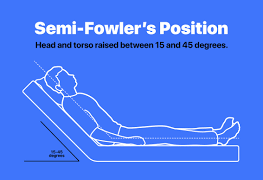The nurse has applied a topical agent to the client's skin, and then applies an ice pack to the area. This is done to:
decrease discomfort to the skin.
slow absorption of the drug
enhance drug excretion
maximize drug distribution
The Correct Answer is B
Choice A rationale: Applying an ice pack after a topical agent is not primarily for decreasing discomfort but rather to achieve a specific therapeutic effect.
Choice B rationale: Applying an ice pack can slow the absorption of the topical drug, allowing for prolonged local action.
Choice C rationale: Enhancing drug excretion is not typically achieved by applying an ice pack.
Choice D rationale: Maximizing drug distribution is not the primary purpose of applying an ice pack after a topical agent.
Nursing Test Bank
Naxlex Comprehensive Predictor Exams
Related Questions
Correct Answer is D
Explanation
Choice A rationale: The Trendelenberg position is not typically used for dyspnea; it involves placing the body in a supine position with the lower half tilted downward. Choice B rationale: The side-lying position is not typically used for dyspnea.
Choice C rationale: The supine position may worsen dyspnea, especially in individuals with respiratory distress.
Choice D rationale: The semi-Fowler's position, with the head of the bed elevated, is often used to assist with breathing and improve oxygenation in clients with dyspnea.

Correct Answer is A
Explanation
Choice A rationale: A DTI is a type of pressure injury that occurs when the skin and underlying soft tissue are compressed between a bony prominence and an external surface for a prolonged period of time.
Choice B rationale: Dressing changes for a DTI would depend on the severity and characteristics of the injury, but a specific frequency is not universally prescribed. Choice C rationale: A DTI is not typically caused by overhydration but is associated with pressure-related damage to underlying tissues.
Choice D rationale: DTI is not a partial thickness injury, but rather an injury to the deep layers of tissue that may not be visible on the surface. A partial thickness injury involves damage to the epidermis and/or dermis, such as a stage 2 pressure ulcer.
Whether you are a student looking to ace your exams or a practicing nurse seeking to enhance your expertise , our nursing education contents will empower you with the confidence and competence to make a difference in the lives of patients and become a respected leader in the healthcare field.
Visit Naxlex, invest in your future and unlock endless possibilities with our unparalleled nursing education contents today
Report Wrong Answer on the Current Question
Do you disagree with the answer? If yes, what is your expected answer? Explain.
Kindly be descriptive with the issue you are facing.
